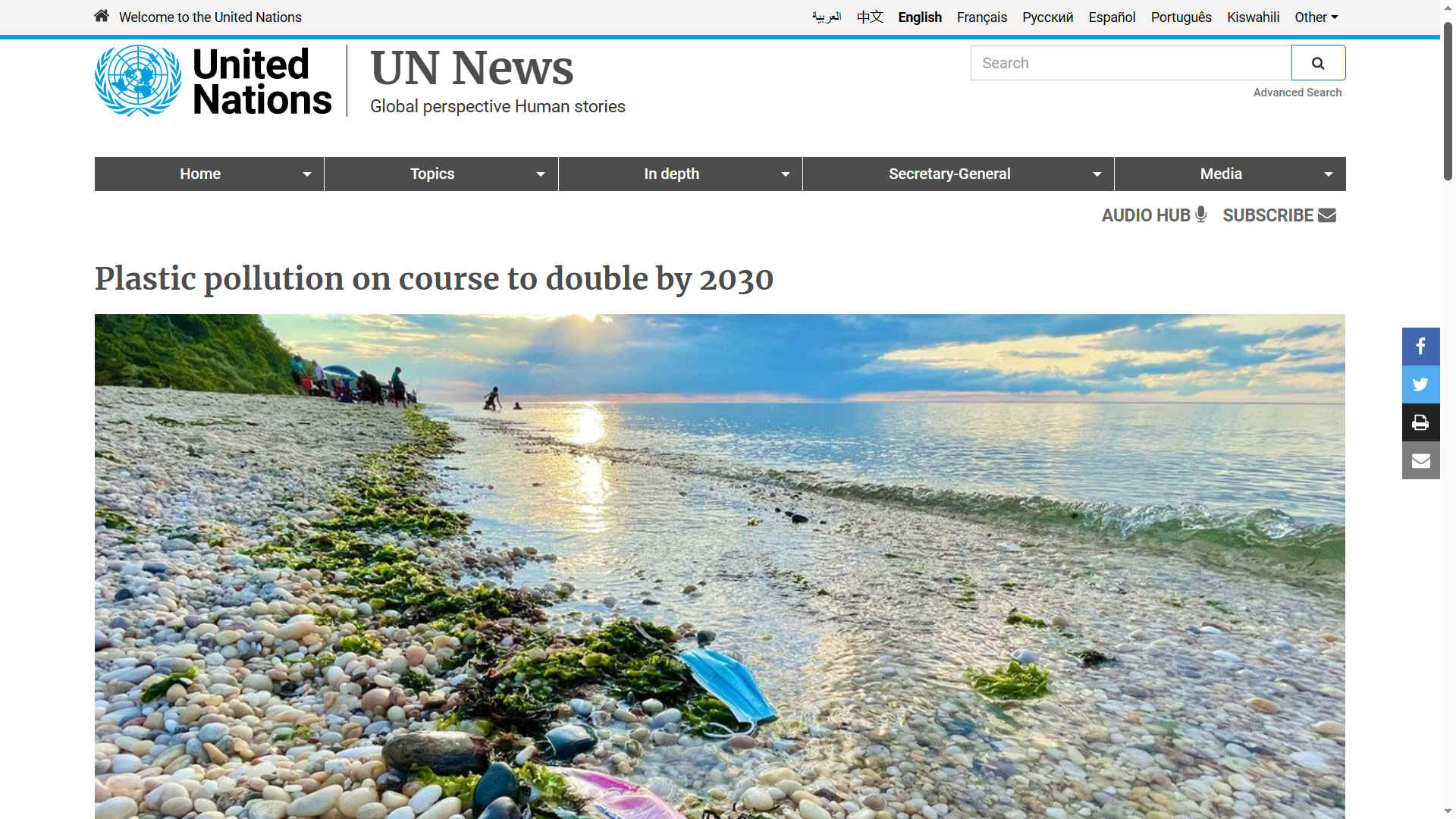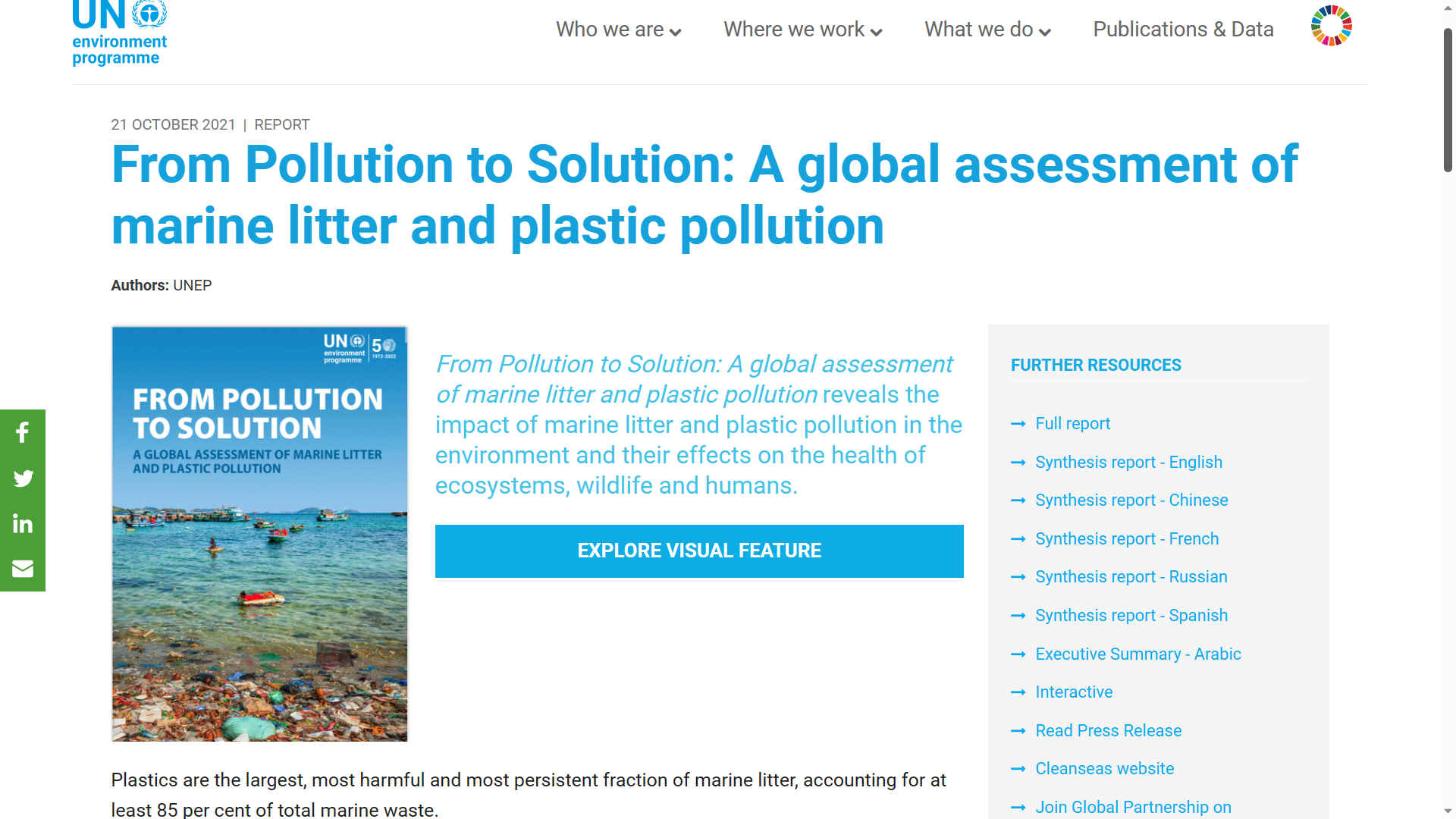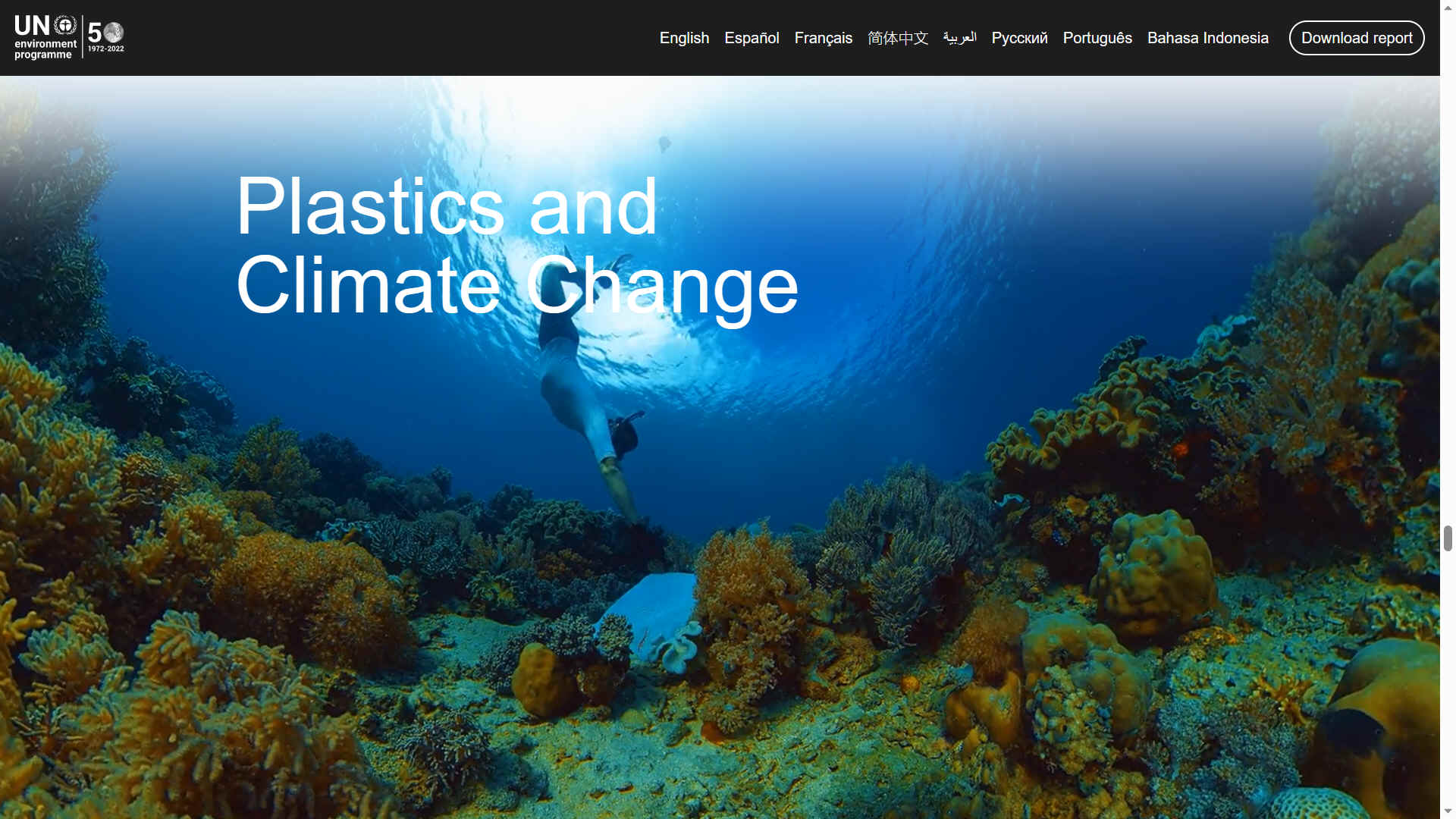|
UN
NEWS - PLASTIC
POLLUTION TO DOUBLE BY 2030
CLIMATE -
NUCLEAR
- OCEAN PLASTIC
- WHALING
PLEASE
USE OUR A-Z INDEX
TO NAVIGATE THIS SITE OR SEE OUR HOMEPAGE

UNEP
REPORT OCTOBER 2021 - Plastic pollution in our oceans is set
to double by 2030, with recycling not enough (we told you so)
and global cooperation needed (we told you so again). Don't
let the politician spin doctors protract enacting a solution
any longer. If shoppers were to boycott plastic wrapped
products, apart from the fact they may starve, supermarket
suppliers would be forced to switch to paper, glass and metal
packaging - or face bankruptcy. The fact politicians allow
them to continue as they are tells us that it is the policy
makers who are to blame. And, they like it as it is, lots of
money for them, backhanders (dividends) or not, taxes as
income from plastic products is akin to procurement fraud -
for any government involved.
UNEP
NEWS 21 OCTOBER 2021 CLIMATE & ENVIRONMENT
Plastic pollution in oceans and other bodies of water continues to grow sharply and could more than double by 2030, according to an assessment released on Thursday by the UN Environment Programme (UNEP).
The report highlights dire consequences for health, the economy, biodiversity and the climate. It also says a drastic reduction in unnecessary, avoidable and problematic plastic, is crucial to addressing the global pollution crisis overall.
To help reduce plastic waste at the needed scale, it proposes an accelerated transition from fossil fuels to
renewable
energies, the removal of subsidies and a shift towards more circular approaches towards reduction.
Titled From Pollution to Solution: a global assessment of marine litter and
plastic
pollution, the report shows that there is a growing threat, across all ecosystems, from source to sea.
SOLUTIONS TO HAND
But it also shows that there is the know-how to reverse the mounting crisis, provided the political will is there, and urgent action is taken.
The document is being released 10 days ahead of the start of the crucial UN Climate Conference,
COP26, stressing that plastics are a climate problem as well.
For example, in 2015, greenhouse gas emissions from plastics were 1.7 gigatonnes of
CO2 equivalent; by 2050, they’re projected to increase to approximately 6.5 gigatonnes. That number represents 15 per cent of the whole global carbon budget - the amount of greenhouse gas that can be emitted, while still keeping warming within the Paris Agreement goals.
RECYCLING NOT ENOUGH
Addressing solutions to the problem, the authors pour cold water on the chances of recycling our way out of the plastic pollution crisis.
They also warn against damaging alternatives, such as bio-based or biodegradable plastics, which currently pose a threat similar to conventional plastics.
The report looks at critical market failures, such as the low price of virgin
fossil fuel feedstocks (any renewable biological material that can be used directly as a fuel) compared to recycled materials, disjointed efforts in informal and formal plastic waste management, and the lack of consensus on global solutions.
Instead, the assessment calls for the immediate reduction in plastic production and consumption, and encourages a transformation across the whole value chain.
It also asks for investments in far more robust and effective monitoring systems to identify the sources, scale and fate of plastic. Ultimately, a shift to
circular approaches and more alternatives are necessary.
MAKING THE CASE FOR CHANGE
For the Executive Director of UNEP, Inger Andersen, this assessment “provides the strongest scientific argument to date for the urgency to act, and for collective action to protect and restore our oceans, from source to sea.”
She said that a major concern is what happens with breakdown products, such as microplastics and chemical additives, which are known to be toxic and hazardous to human and wildlife health and ecosystems.
“The speed at which ocean plastic pollution is capturing public attention is encouraging. It is vital that we use this momentum to focus on the opportunities for a clean, healthy and resilient ocean”, Ms. Andersen argued.
GROWING PROBLEM
Currently, plastic accounts for 85 per cent of all marine litter.
By 2040, it will nearly triple, adding 23-37 million metric tons of waste into the ocean per year. This means about 50kg of plastic per meter of coastline.
Because of this, all marine life, from plankton and
shellfish; to birds,
turtles and mammals; faces the grave risk of toxification, behavioral disorder, starvation and suffocation.
The human body is similarly vulnerable. Plastics are ingested through seafood, drinks and even common salt. They also penetrate the skin and are inhaled when suspended in the air.
In water sources, this type of pollution can cause hormonal changes, developmental disorders, reproductive abnormalities and even cancer.
Economy
According to the report, there are also significant consequences for the global economy.
Globally, when accounting for impacts on tourism, fisheries and
aquaculture, together with the price of projects such as clean-ups, the costs were estimated to be six to 19 billion dollars per year, during 2018.
[SeaVax
presented as an affordable solution in 2021: 300 units (total
clean) @ $6m = $1.8b billion dollars, or river only
containment 100 units = $600m dollars. Either way, monitoring
would be effective. With the dream team gone, a lost
opportunity perhaps. Save that, another bio-engineering
champion could be sourced, if nations were committed to
support. There is no such thing as a free lunch, as the G7/20/EU
appear to believe. Cheap yes, free no. Volunteer beach
cleaning is not a solution as they no doubt hoped.]
By 2040, there could be a $100 billion annual financial risk for businesses if governments require them to cover waste management costs. It can also lead to a rise in illegal domestic and international waste disposal.
The report will inform discussions at the UN Environment Assembly in 2022, where countries will come together to decide a way forward for more global cooperation.

FROM
POLLUTION TO SOLUTION: A GLOBAL ASSESSMENT OF MARINE LITTER
& PLASTIC POLLUTION
From Pollution to Solution: A global assessment of marine litter and plastic pollution reveals the impact of marine litter and plastic pollution in the environment and their effects on the health of ecosystems, wildlife and humans.
Plastics are the largest, most harmful and most persistent fraction of marine litter, accounting for at least 85 per cent of total marine waste.
The assessment examines the magnitude and severity of marine litter and plastic pollution and reviews existing solutions and actions. The assessment demonstrates that there is a growing threat from marine litter and plastic pollution in all ecosystems from source to sea. It provides a comprehensive update on current research (and knowledge gaps) with respect to direct impacts on marine life, risks posed to ecosystems and human health, and social and economic costs.
Overall, the assessment, which is intended to inform evidence-based action at all levels, underscores the need for urgent, global action. It shows that while we have the know-how, we need the political will and urgent action to tackle this mounting crisis. The report will inform discussions at the UN Environment Assembly (UNEA 5.2) in 2022, where countries will come together to decide a way forward for global cooperation.
What do the deepest point in the ocean, the Mariana trench, and the highest mountain peak in the world, Mt. Everest, have in common?
Despite being among the planet's most remote and inaccessible environments, they both contain tiny pieces of plastic from human activities miles away.
Plastics are the largest, most harmful and persistent fraction of marine litter, accounting for at least 85 per cent of total marine waste.
Marine litter is found in increasing volumes along our coastlines and estuaries, in massive swirling mid-ocean currents, on remote islands, in sea ice ...
… across the sea floor from the polar regions down into the deepest darkest trenches, harming marine life and damaging habitats across its path.
Over the last 70 years, plastic - an incredibly malleable, versatile, and durable material - infiltrated the market and permeated seemingly every nook and cranny on Earth. Plastics can provide important benefits, from life-saving medical devices to safe and long-life food storage. However, unnecessary and avoidable plastics, particularly single-use packaging and disposable items, are polluting our planet at alarming rates. Decades of economic growth and an increasing dependency on throw-away plastics has led to a torrent of unmanaged waste that pours into lakes, rivers, coastal environments, and finally out to sea, triggering a ripple of problems.
From Pollution to Solution: a global assessment of marine litter and plastic pollution shows that there is a growing threat in all ecosystems from source to sea. It also shows that while we have the know-how, we need the political will and urgent action by government to tackle the mounting crisis. The report will inform priority actions at the UN Environment Assembly (UNEA 5.2) in 2022, where countries will come together to decide a way forward for global cooperation. The new UN Report forewarns that unless we get a handle on our plastics problem:
The estimated 11 million metric tons of plastic currently entering the ocean annually will triple in the next twenty years.
This means that between 23 and 37 million metric tons of plastic will flow into the oceans every year by 2040.
That is equivalent to 50 kilograms of plastics per metre of coastline worldwide …
… or the weight of as many as 178 Symphony of the Seas, the largest cruise ship in the world.
The problem has burgeoned into a global crisis requiring both immediate and sustained attention and action. This assessment provides the definitive wake-up call to the ubiquity of marine litter and the adverse impacts of plastic pollution – from environmental degradation to economic losses for communities and industries, to human health risks – and shows us how we can do better. It’s time to join hands to turn the tide on marine litter and plastic pollution by implementing the many – great and small – solutions at hand, with urgency, innovation, commitment and accountability.
Microplastics and nanoplastics are plastic debris which range from 5 millimeters long to less than a few nanometres long.
HARM TO MARINE LIFE
Marine litter and plastic pollution are problematic for many reasons. Plastics don’t biodegrade (decompose naturally in a way that’s not harmful to the environment). Instead, they break down over time into ever smaller pieces known as microplastics and nanoplastics, which can have unquantifiable adverse impacts.
Impacts to marine life range from physical or chemical harm to individual animals, to wider effects on biodiversity and ecosystem functioning. Pieces of plastic have been found in the digestive system of many aquatic organisms, including in every marine turtle species and nearly half of all surveyed seabird and marine mammal species.
Sea turtles mistake floating plastic bags for jellyfish, slowly starving as their stomachs fill with indigestible trash.
Seabirds peck at plastics because it smells and looks like food.
Marine mammals, sea turtles and other animals often drown after becoming trapped in lost or discarded plastics including packaging or fishing gear.
A leading cause of death for North Atlantic right whales, one of the world's most critically endangered whales, is being ensnared in ghost fishing gear.
There are less obvious impacts too. Not only do the toxins already found in plastics affect the ocean food web but plastic pieces are known to soak up pollutants that flow off land into the sea, including pharmaceutical and industrial waste. The toxicity can transfer through the food chain as marine species eat and are eaten. There is also a growing concern about non-native species hitching a ride across the ocean on floating trash into foreign seas and soil, such as algae, mollusks and barnacles, which can invade and degrade distant aquatic environments and species. It would be remiss not to mention that most plastic garbage in the ocean eventually sinks to the seabed like a submerged trash pile, smothering coral reefs and seafloor marine life below, explains the assessment.
HARM TO HUMANS
Humans are also at risk from marine plastic pollution. Environmental health is inextricably linked to human health. The pervasiveness of microplastics across our planet raises serious concerns for people's safety. New research shows that people are inhaling microplastics through the air, consuming them through food and water and even absorbing them through the skin. Microplastics have even been found within our lungs, livers, spleen, and kidneys, and one study recently found microplastics in the placentas of newborn babies.
The full extent of the impact on human health is still unknown since the research is nascent. There is, however, substantial evidence that plastics-associated chemicals, such as methyl mercury, plasticizers and flame retardants, can enter the body and are linked to health concerns, especially in women. Scientists also believe that some of the common chemicals found in plastics, such as bisphenol A, phthalates, and polychlorinated biphenyls (PCBs), could leach into the body. These chemicals have been linked to endocrine disruption, developmental disorders, reproductive abnormalities and cancer. That’s reason enough for a precautionary approach to be adopted.
The impacts of plastic pollution aren’t felt equally around the world. Wealthier countries produce more plastic waste, which all too frequently flows into less developed countries where waste management is the least sophisticated. Recycling helps reduce plastic production and plastic waste. However, recycling rates remain low worldwide. Even economically advanced countries like the United States are only at 9 per cent.
Communities in developing countries are the least capable of managing the environmental, health, social and cultural burden of plastic pollution due to a lack of government support or funds. That means women, children, waste workers, coastal communities, Indigenous Peoples and people who depend on the ocean feel the impacts more intensely, particularly when moving or burning mismanaged waste. It also means these economies suffer as they're suffocated by plastics.
Marine plastics negatively impact the ability of myriad ecosystems to provide the basic benefits that humans both enjoy and take for granted, which range from clean water to productive aquaculture and fisheries, pest and disease control, climate regulation, heritage and recreation. According to the Pollution to Solution Assessment, marine plastics pollution reduces valuable marine ecosystem service by at least US$500 billion to US$2,500 billion each year, and that’s not including other social and economic losses like tourism and shipping.
The Assessment finds that the direct economic losses to coastal and maritime industries, such as fisheries and shipping, are significant. In the Mediterranean region, these losses have been estimated at close to US$138 million per year. In the Asia Pacific Economic Cooperation region, the losses total US$10.8 billion, a nearly ten-fold increase compared to 2009. However, these losses aren’t well reported, and the true costs of marine litter and plastics pollution on human, environmental, and social health are still being discovered.
PLASTICS AND CLIMATE CHANGE
Plastics are also a climate problem. Not everyone knows that plastic is produced from oil, a fossil fuel. The more plastic we make, the more fossil fuel required, the more we intensify the climate crisis in a continual negative feedback loop. Also, plastic products create greenhouse gas emissions across their whole lifecycle. If no action is taken, greenhouse gas emissions from the production, recycling and incineration of plastics could account for 19 per cent of the Paris Agreement's total allowable emissions in 2040 if we're on track to limit warming to 1.5 degrees Celsius.
In recent years, there has been an increased urgency to protect the ocean and seas to tackle climate change. The ocean is the planet's largest carbon sink, storing as much as 90 per cent of the additional heat that carbon emissions have trapped in our atmosphere and one-third of the additional carbon dioxide generated since the industrial revolution. Absorbing large quantities of carbon has slowed the visible impacts of a warming planet – but also accelerated catastrophic effects below the water's surface – a warming, acidifying and chemically imbalanced ocean.
Carbon is sequestered in every component of the ocean, especially mangroves, seagrass, corals and salt marshes. The more damage we do to our ocean and coastal areas, the harder it is for these ecosystems to both offset and remain resilient to climate change.
Interestingly, a recent study on marine plastics pollution by GRID-Arendal, a UNEP partner, indicates that the four coastal ecosystems that store the most carbon and serve as natural barriers against rising seas and storms – mangroves, seagrasses, salt marshes and coral reefs – are put under pressure from land-based plastic pollution as a consequence of their proximity to rivers. More than ever, marine litter surveys and research are essential to predict the consequences of pressures, design mitigation approaches, and guide adaptation.
FROM PLASTIC POLLUTION TO SOLUTION
Plastic pollution, biodiversity breakdown, and climate instability are the most pressing planetary crises of our time. The rapid growth of plastic production already poses threats to Earth's natural systems, on which life depends, and it's only projected to get worse. By 2040, plastic waste is expected to present an annual financial risk of US$100 billion for businesses that would need to bear the costs of waste management at expected volumes. It is estimated that in Italy alone, between 160,000 and 440,000 tons of additional waste were produced in 2020 due to intensified reliance on medical protective equipment during the Covid-19 pandemic. If just 1% of the single use masks that contribute to this figure were improperly disposed of, up to 10 million masks might enter and pollute the ocean per month.
While the quantity of marine plastics that we need to tackle is so large it's hard to fathom, science tells us that most of the solutions we need already exist. Numerous regional, national, and local activities are helping reduce the flow of plastic into the ocean, such as the Regional Seas Conventions, national bans on single-use plastics, business commitments to reduce, redesign and reuse plastics, community clean-ups, curbside initiatives, and municipal bag bans.
"Breaking the Plastic Wave", a global analysis of how to change the trajectory of plastic waste, reveals that we can reduce the amount of plastic entering the ocean by about 80 per cent in the next two decades if we utilize existing technologies and solutions.
Continuing with business-as-usual is simply not an option. The “Pollution to Solution” assessment explains that the scale of the problem requires urgent commitments and action at the global level, and from source to sea to achieve the necessary long-term reduction of waste produced on land.
Several existing international agreements and conventions already provide support for reducing marine pollution and litter, combatting climate change (SDG
13), and sustainably using the oceans (SDG
14). The Global Partnership on Marine Litter, the United Nations Convention on the Law of the Sea, and the Convention on Biological Diversity directly relate to the health of the ocean, its ecosystems and marine life. The Basel, Stockholm and Rotterdam conventions relate to the movement and disposal of hazardous waste and chemicals. There is also growing momentum to tackle this scourge.
There is no single solution. As with many intergenerational environmental assaults, this requires systems thinking, innovation and transformation. However, the goal is singular: reduce the use of unnecessary, avoidable and problematic plastics, and stop their flow into our lakes, rivers, wetlands, coasts and seas. We are all in this together, and together, we can, we must, solve the marine litter and plastic pollution problem.
[We
can outlaw plastic, going over to paper, metals and glass for
packaging. Politicians need to grab the bull by the horns and
stop pussy-footing around to assuage fossil fuel interests.
Just create a global statute: the pen can be mightier than the
sword, if the fines are big enough. No SeaVax, or similar
solutions/interventions necessary.]
BLUE
GROWTH MAIN
BLOCKERS
We
are facing four major problems that seriously hinder Blue
Growth:
1.
Ocean Pollution - poisons wild fish, also the source of
feed for aquaculture
2.
Over Fishing - depletes wild fish stocks, threatening food
security & productive fisheries
3.
Climate Change - ocean acidification & fish migration
4.
Over Population - demands more fish than the oceans can at
present provide

MAIN
BLUE GROWTH AREAS
5.
Ocean Regeneration - cleaning our oceans to preserve the
resource and cleanse the toxic food chain
6.
Aquaculture - now generates around 50% of world produce,
mostly subject
to wild fish feed
7.
Ocean Energy - offshore wind and wave energy for clean
power
8.
Biotechnology - Identifying, harvesting and producing
medicines
9.
Coastal Tourism - To engage the public in ocean matters
and reduce air travel
10.
Green Ships - Cargo and cruise ships that are cleaner,
preferably zero carbon
11.
Green
Ports - Ports and docks that are more efficient at
handling passengers and cargo
LINKS
& REFERENCE
https://www.gunterpauli.com/blog/blue-growth
https://www.theblueeconomy.org/

HANDOVER
CEREMONY -
Alberto Laplaine Guimarães is presented
with a gift of maritime art from the children of Burgas and
Ruska Boyadzhieva. Alberto is the Secretary General of Lisbon
City Council and Ruska the Deputy Mayor of Burgas, Bulgaria.
Bulgaria reinforced their commitment to blue growth in a
ministerial statement to conclude this superb event for which
the City of Burgas should be rightly proud. Copyright ©
photograph June 1 2018 Cleaner
Ocean Foundation.
PLEASE
USE OUR A-Z INDEX
TO NAVIGATE THIS SITE OR SEE OUR HOMEPAGE
This
website is provided on a free basis as a public information
service. Copyright © Cleaner
Oceans Foundation Ltd (COFL) (Company No: 4674774)
May 2023.
Solar
Studios, BN271RF, United Kingdom.
COFL
is a charity without share capital.
|



